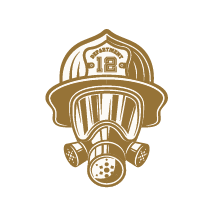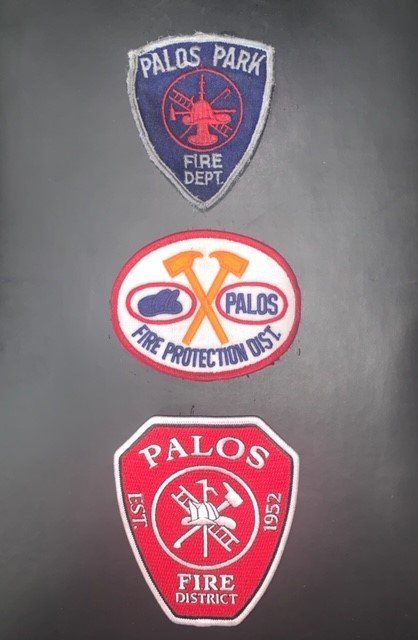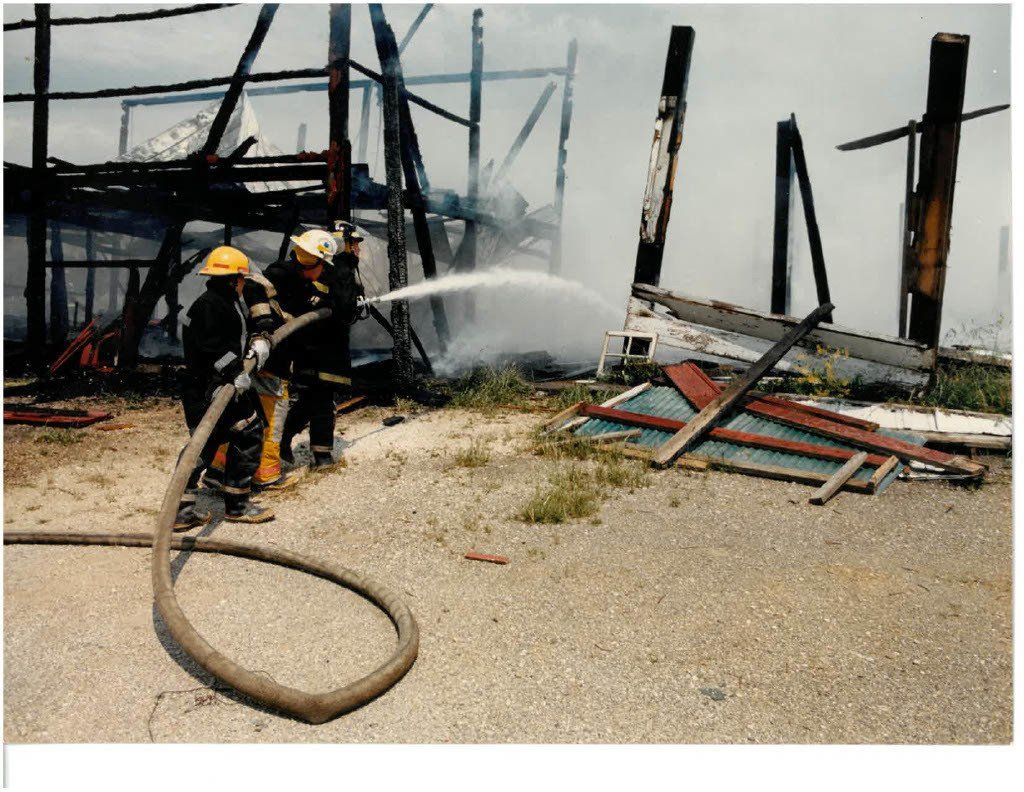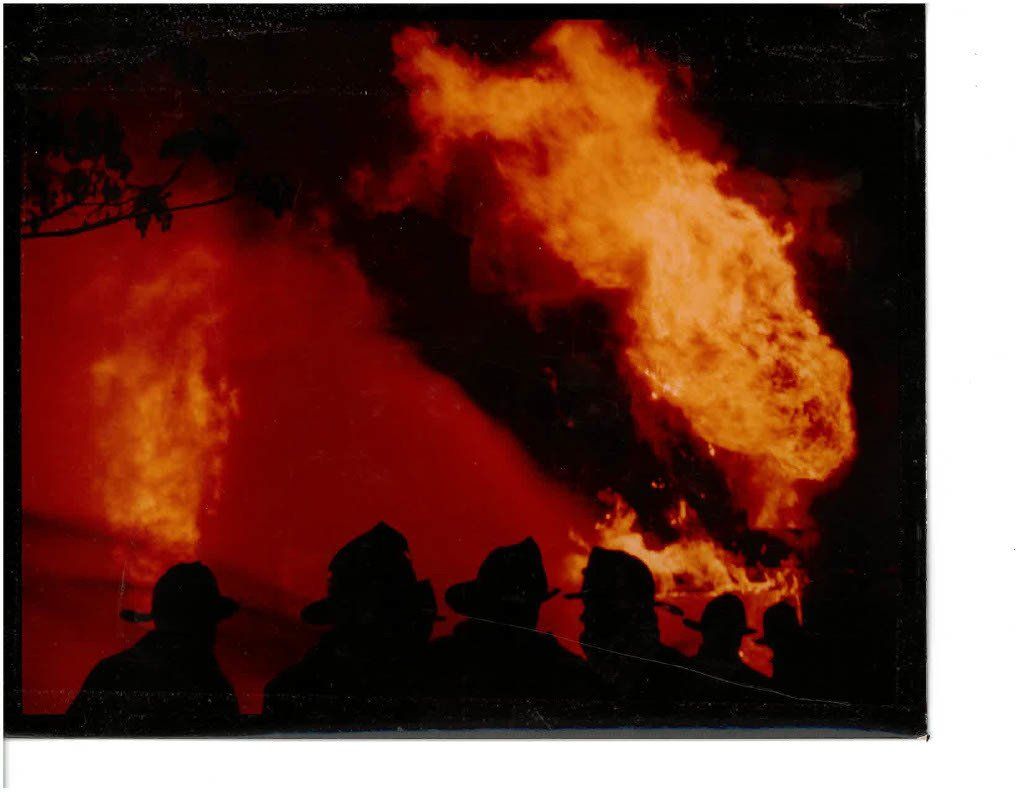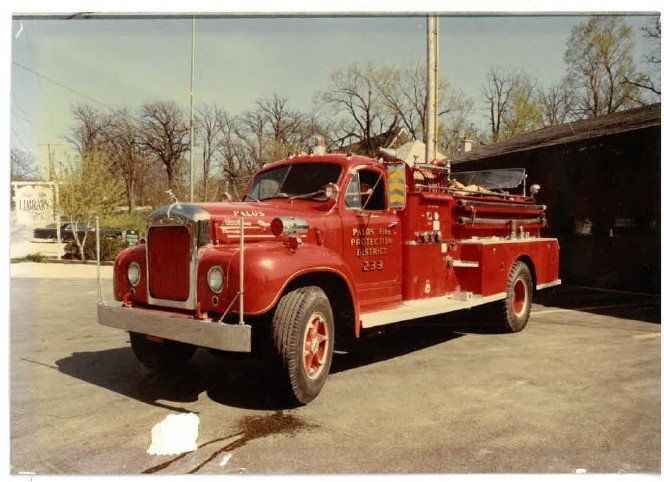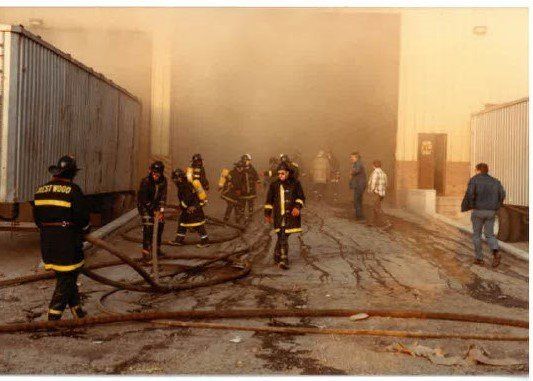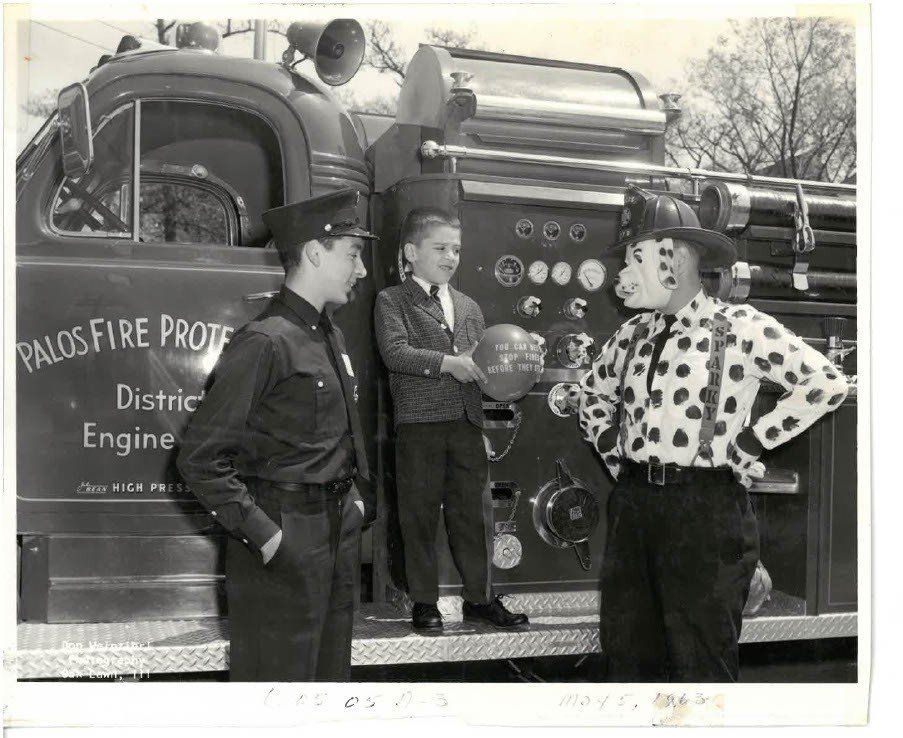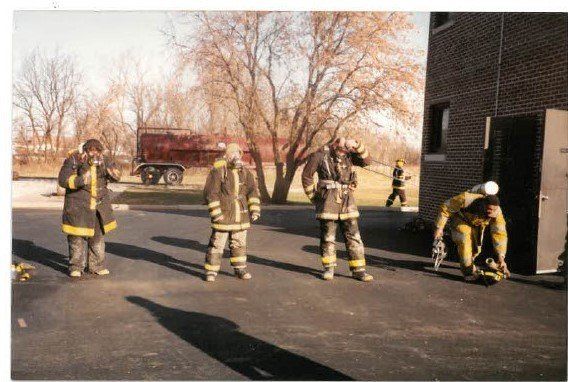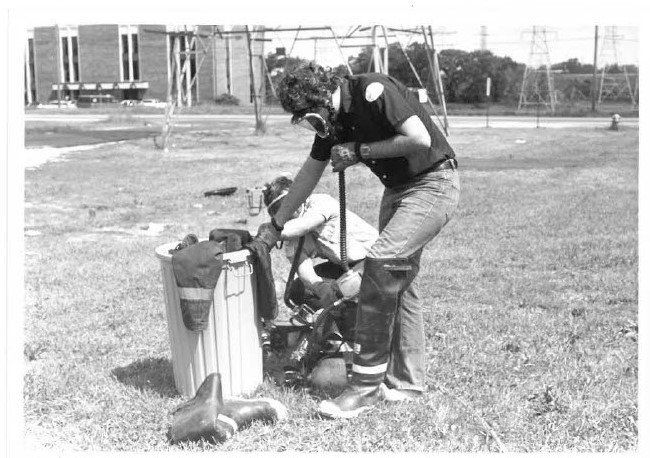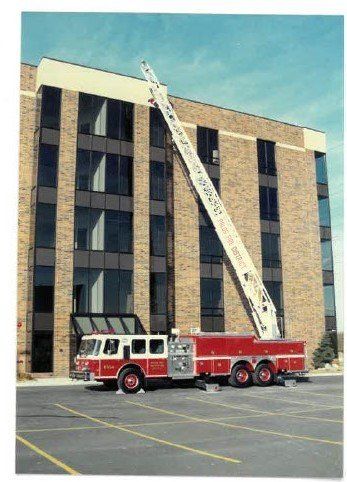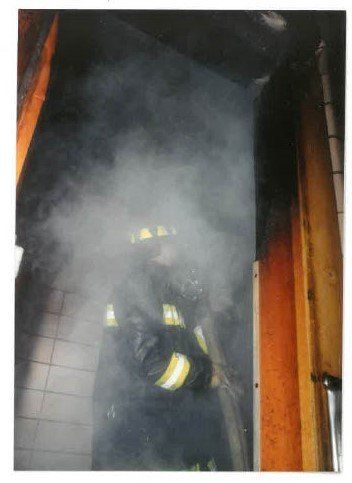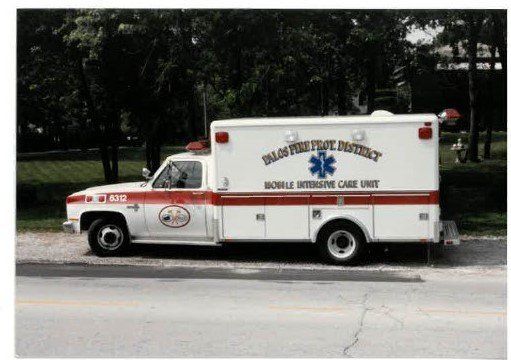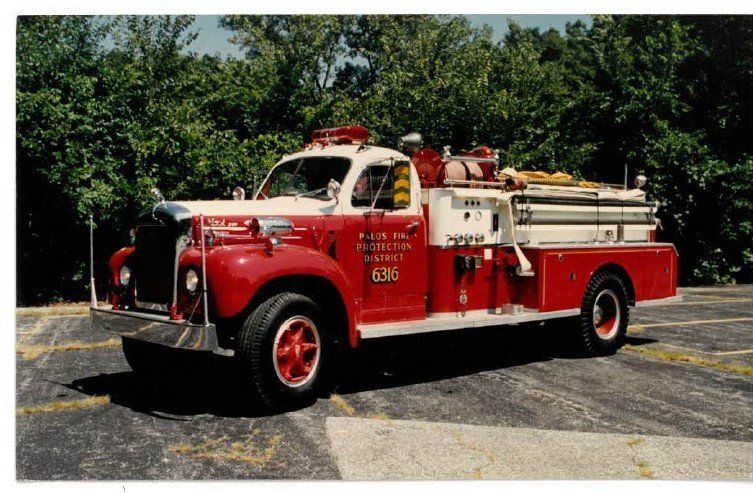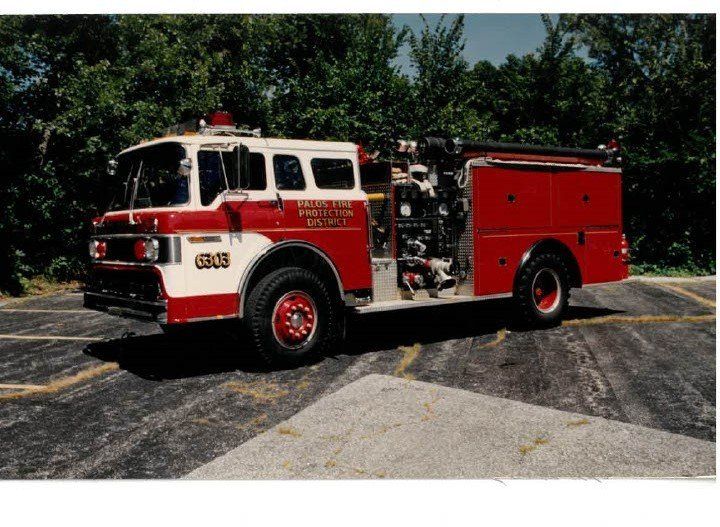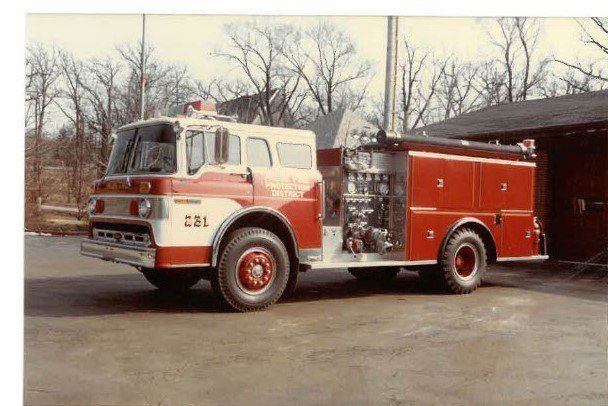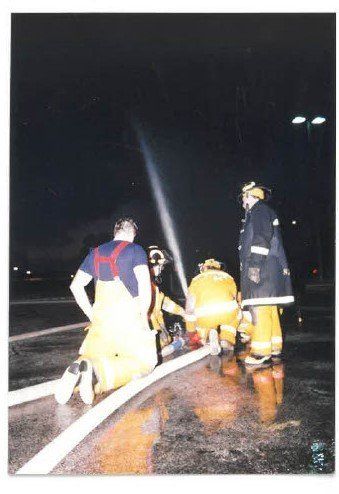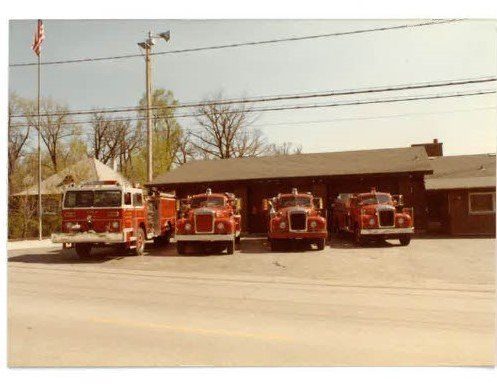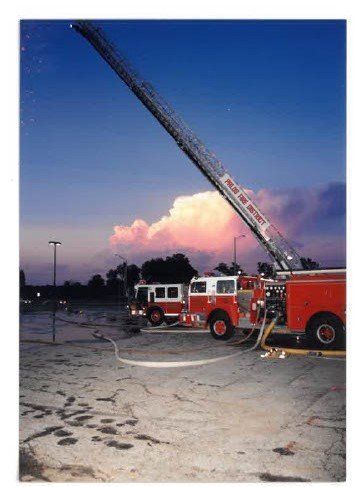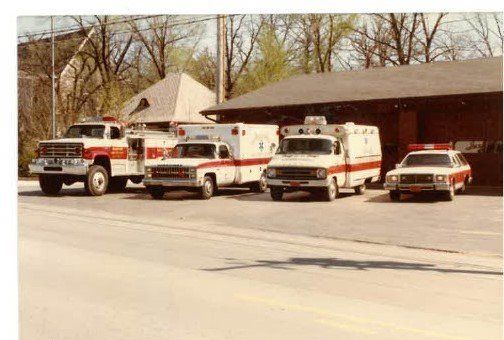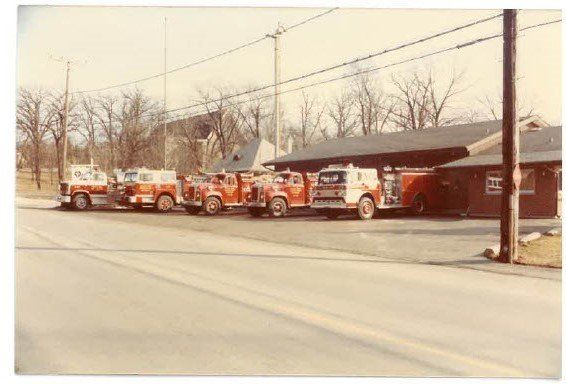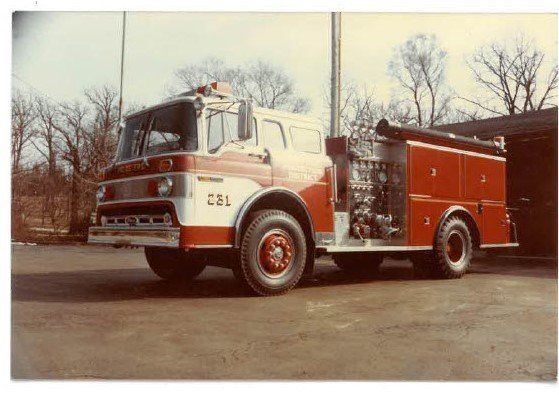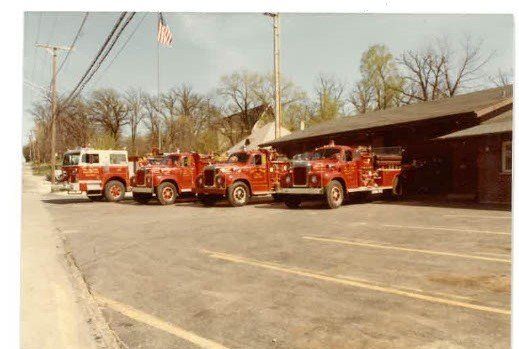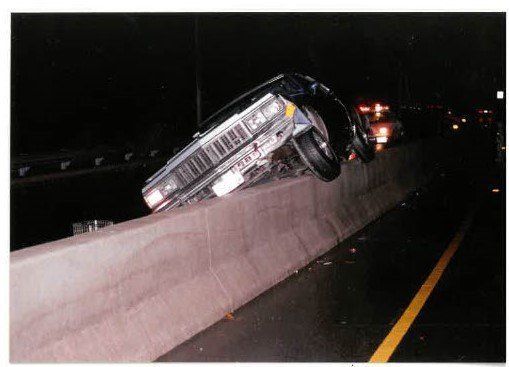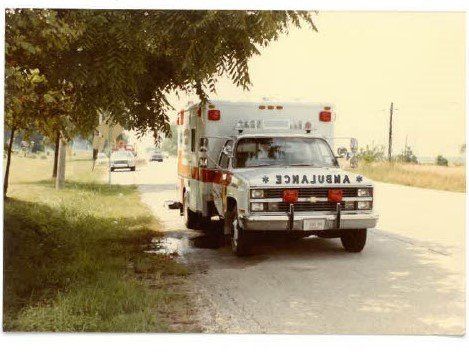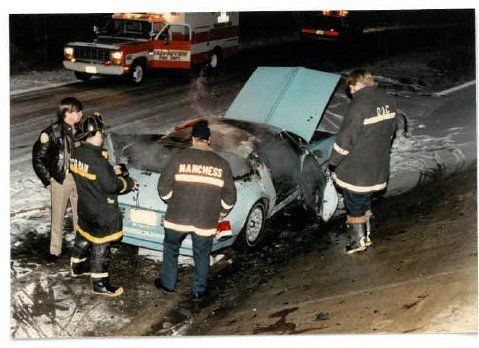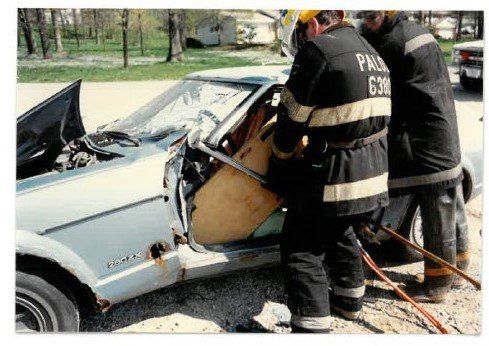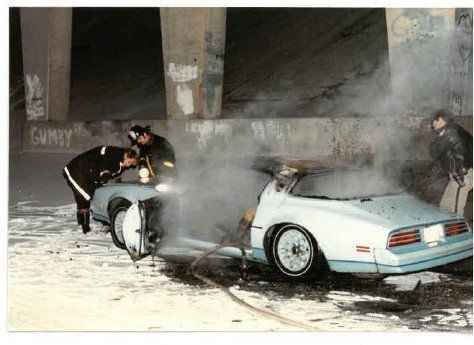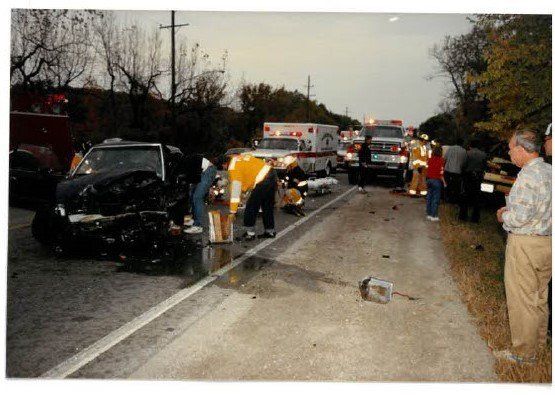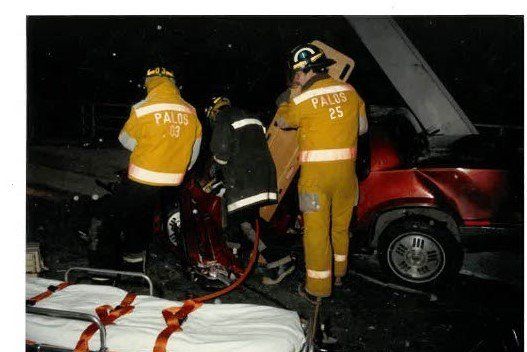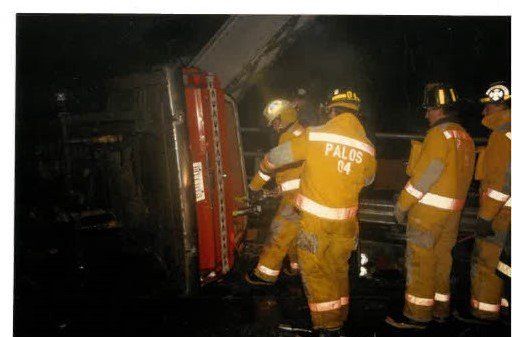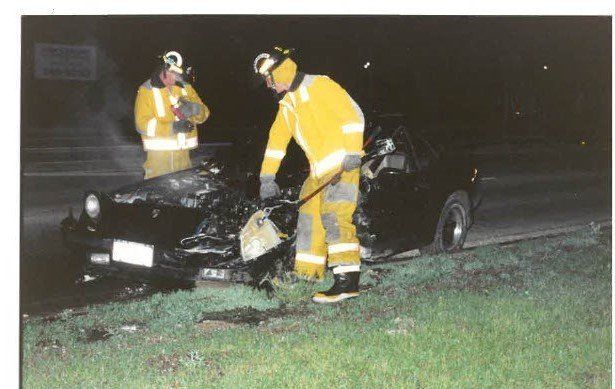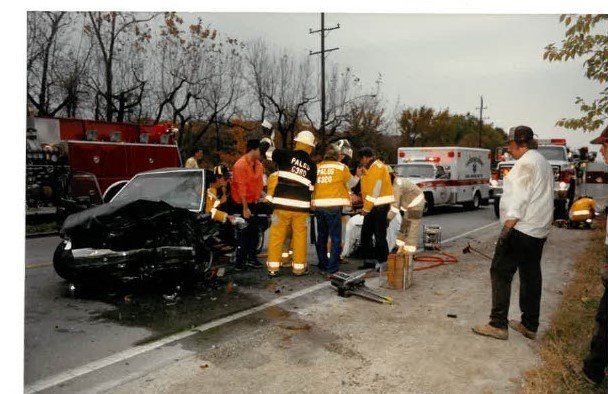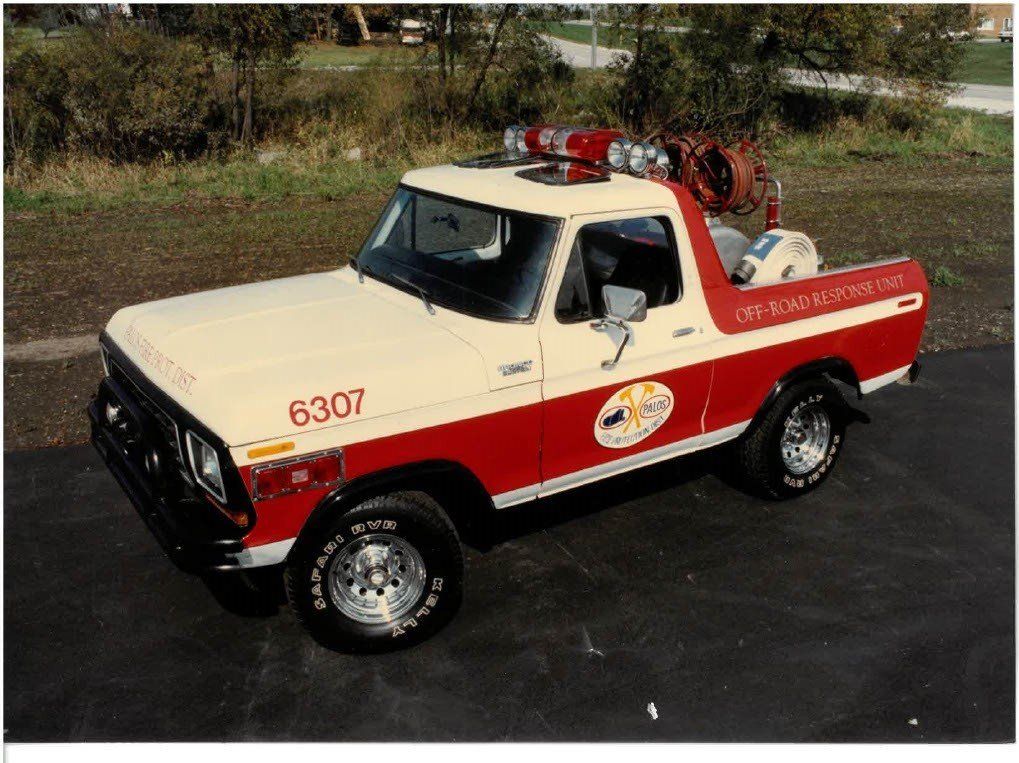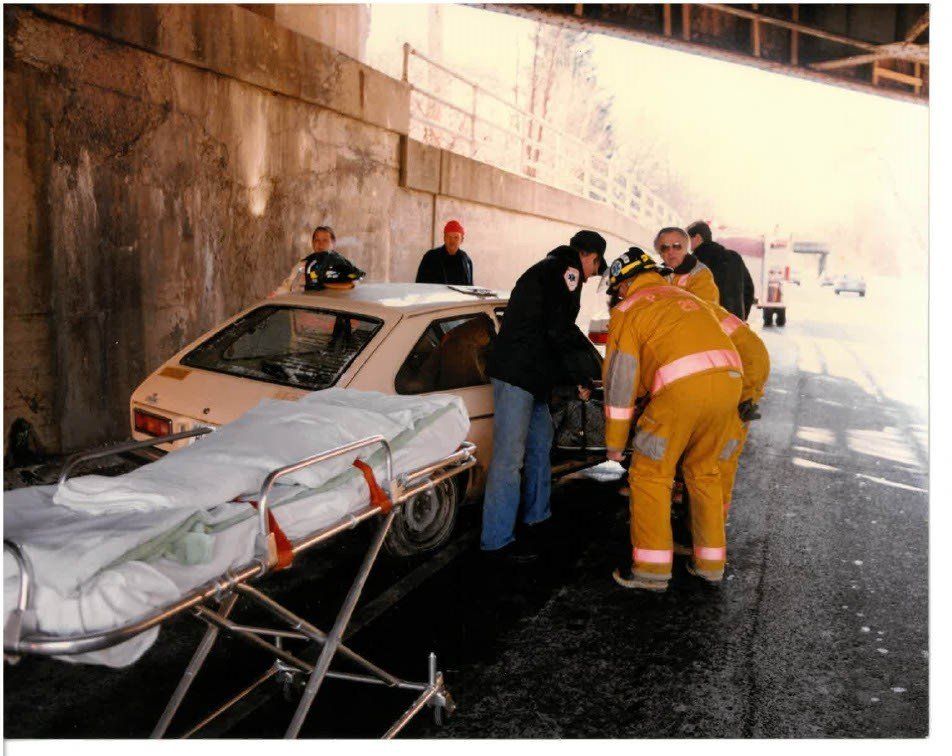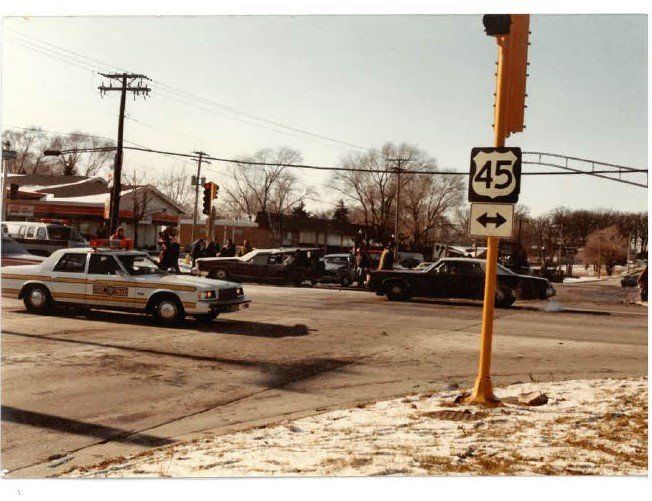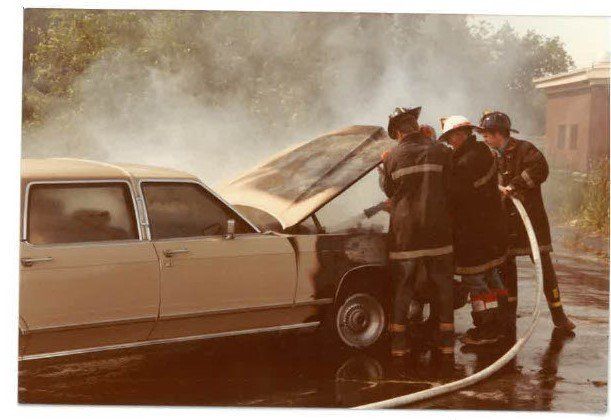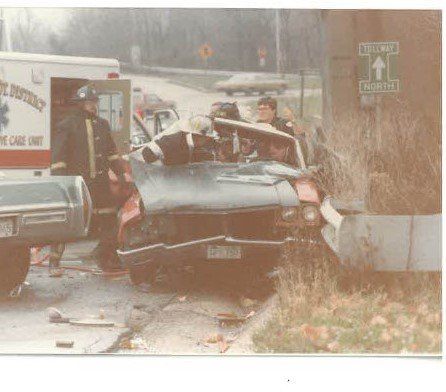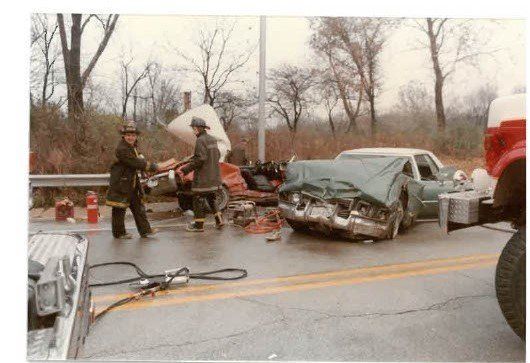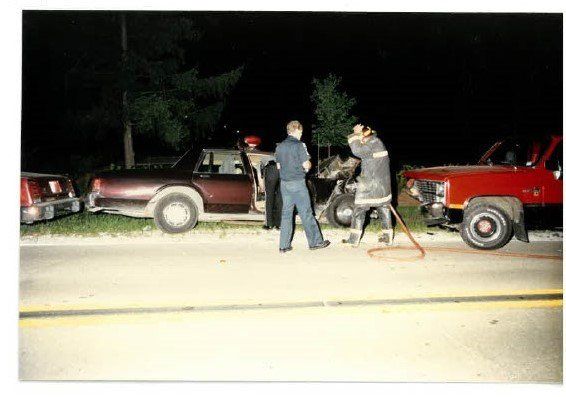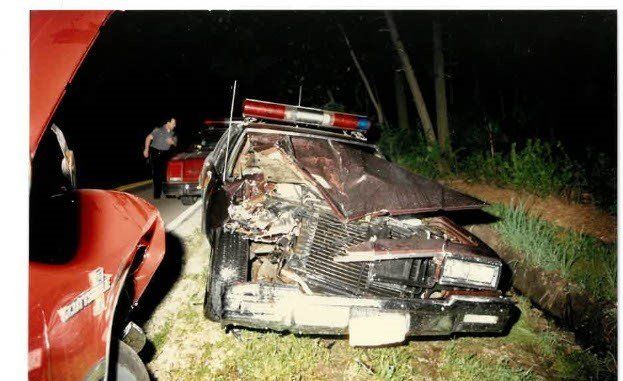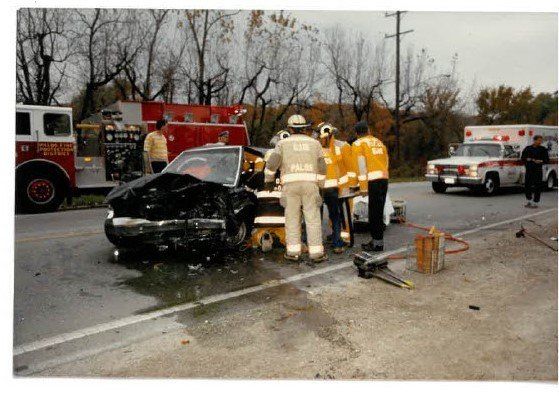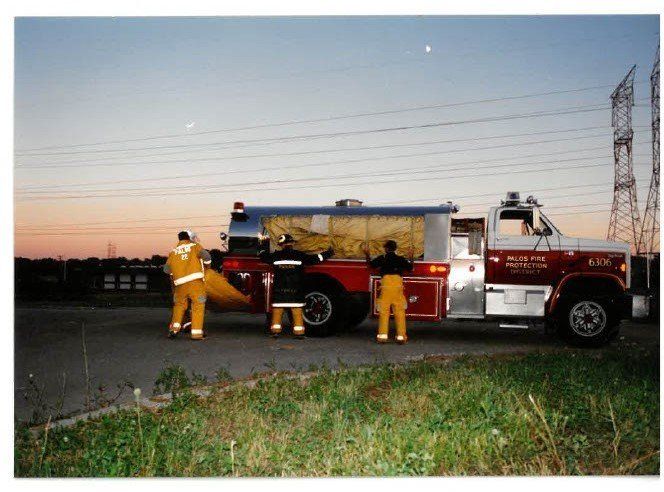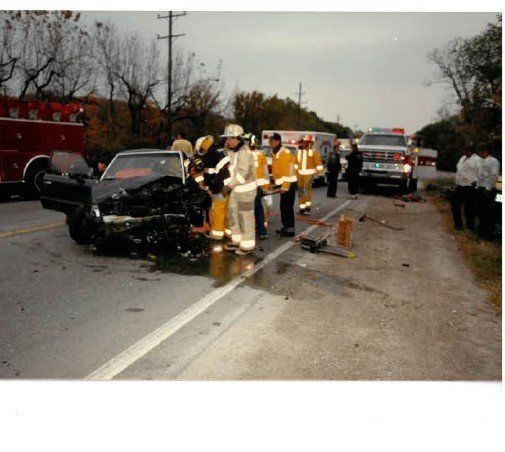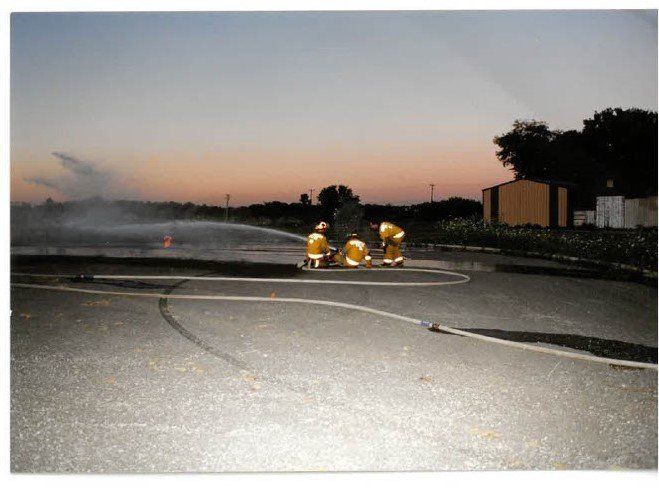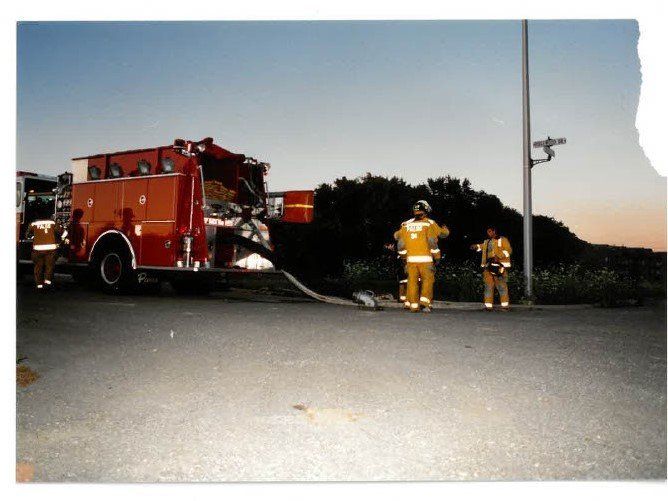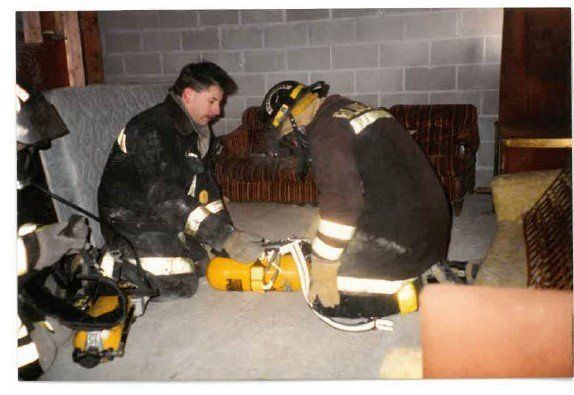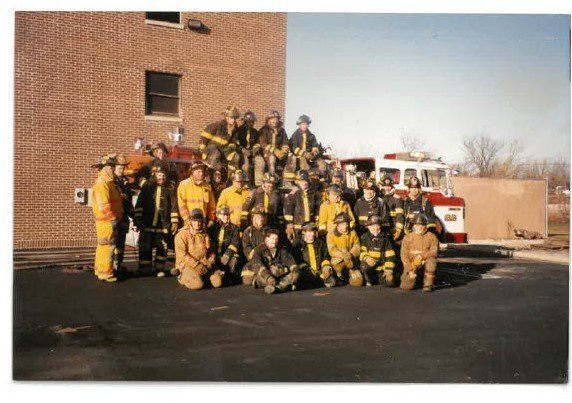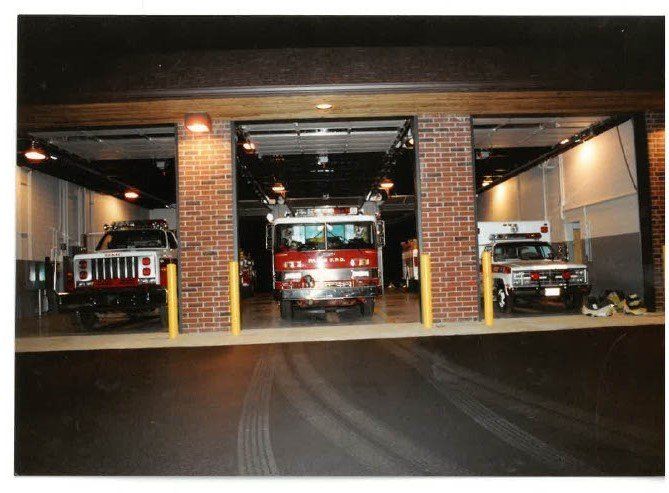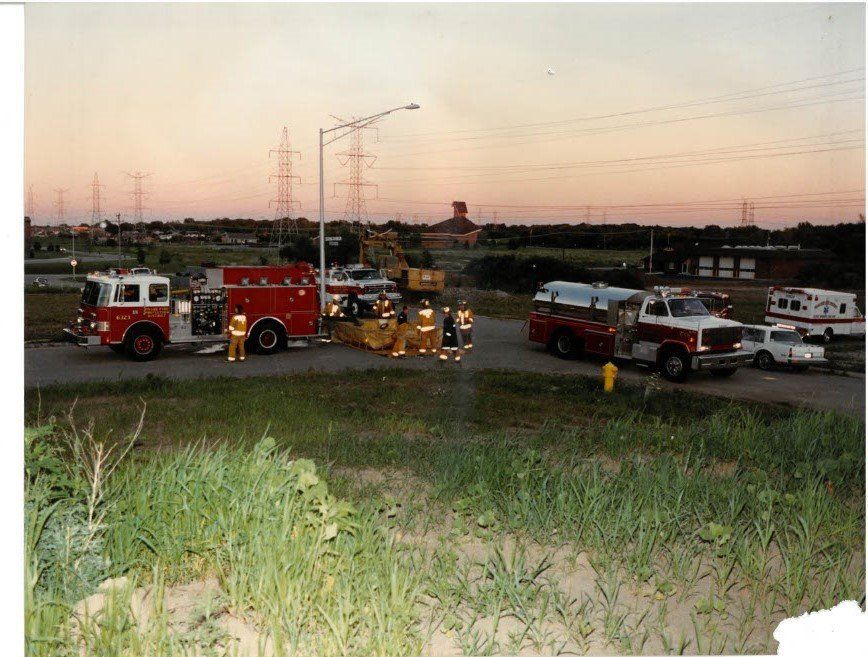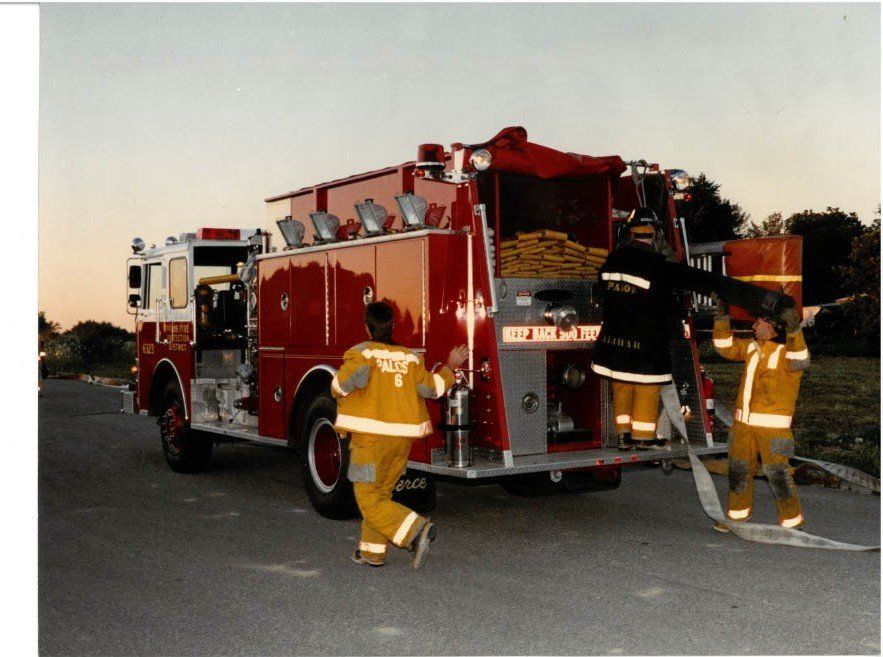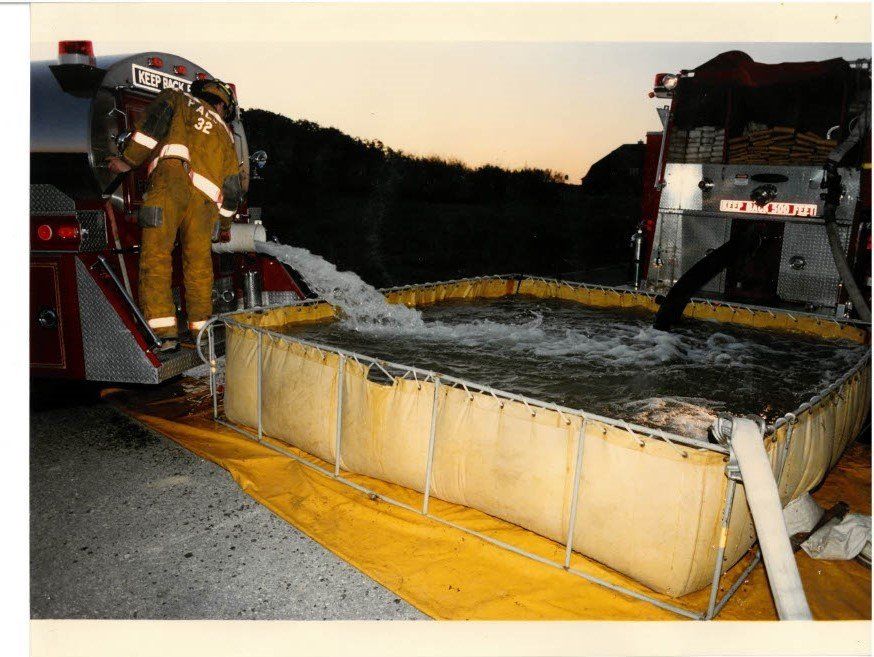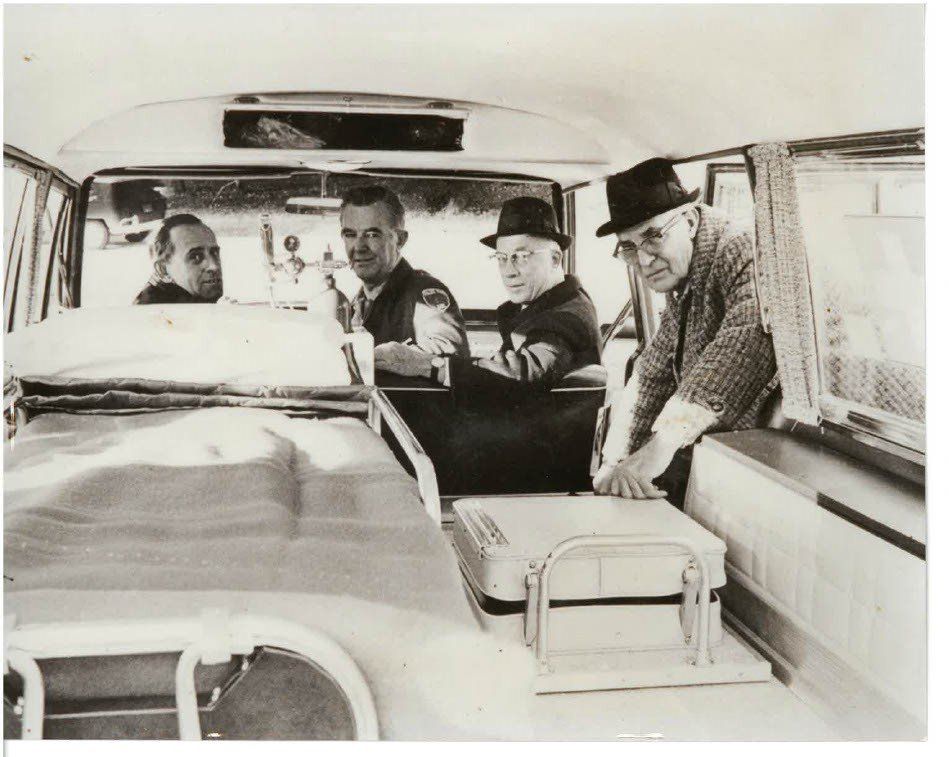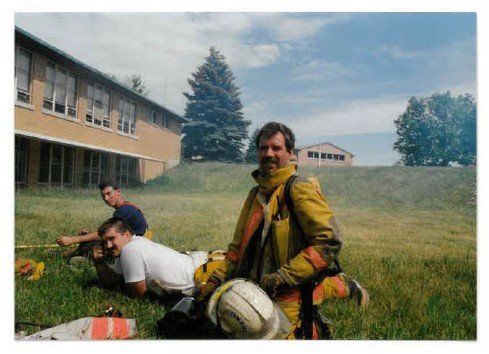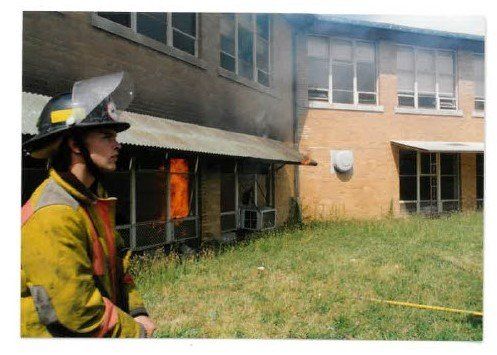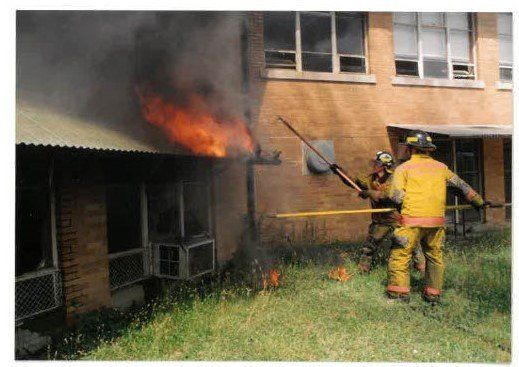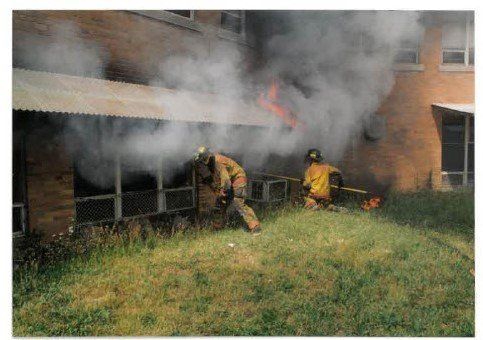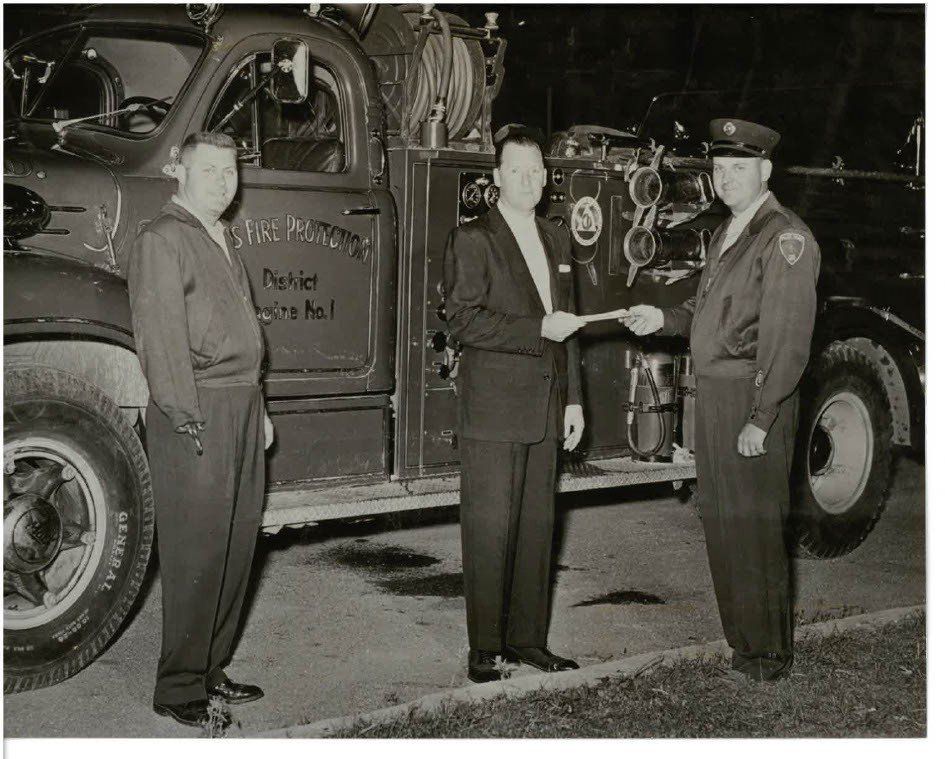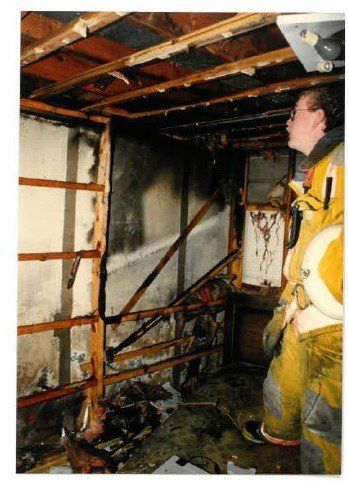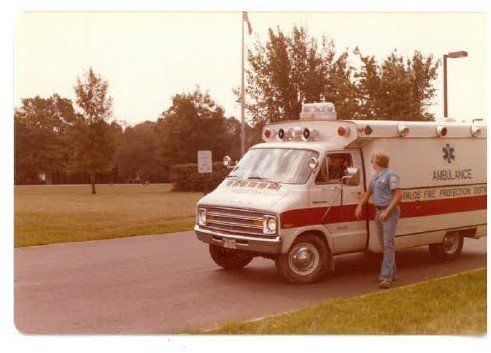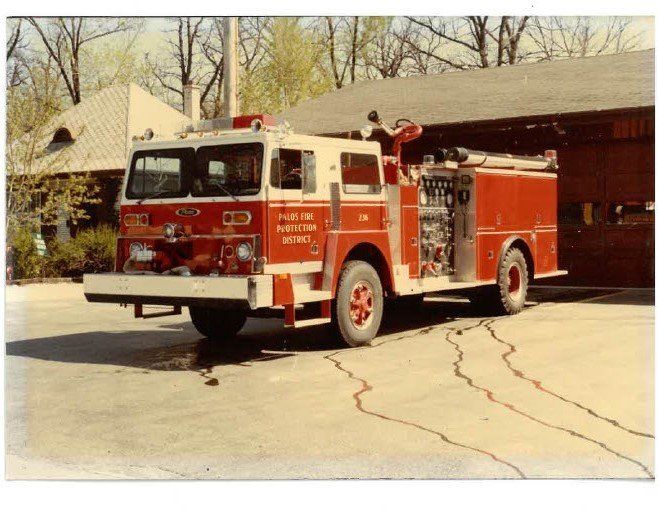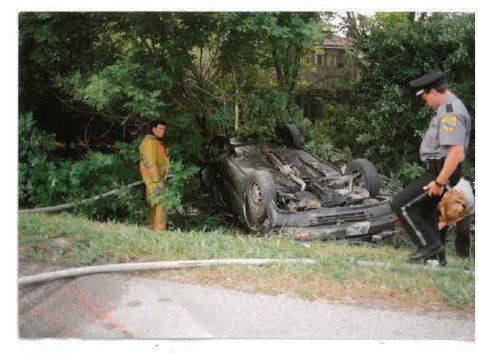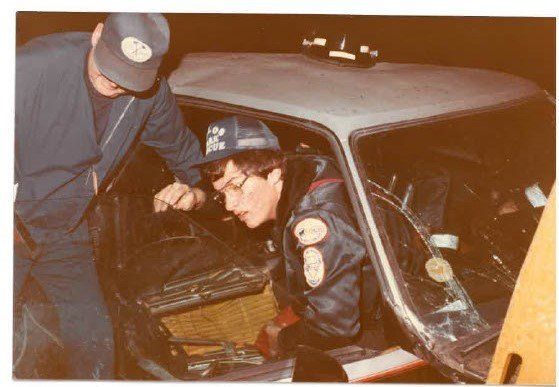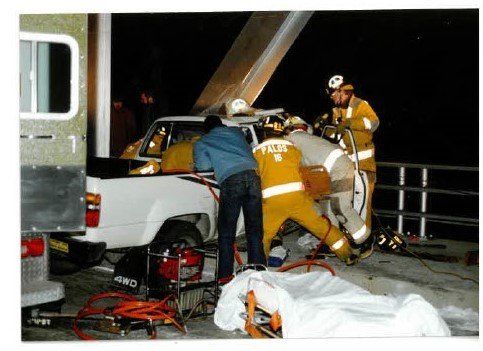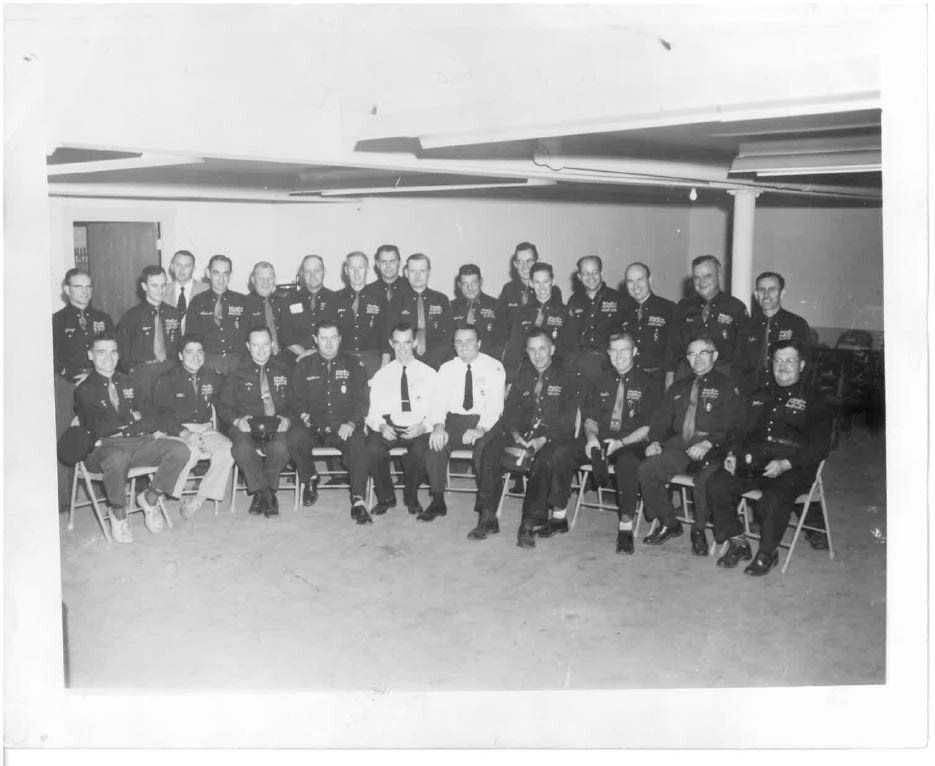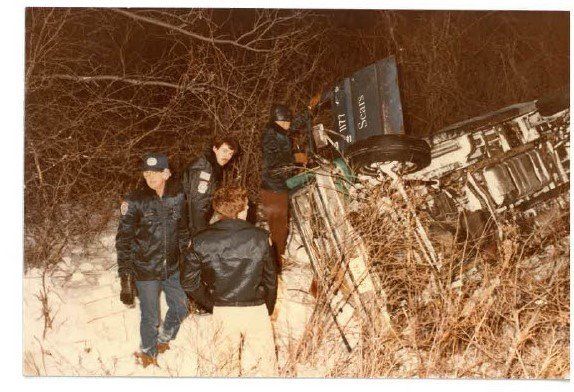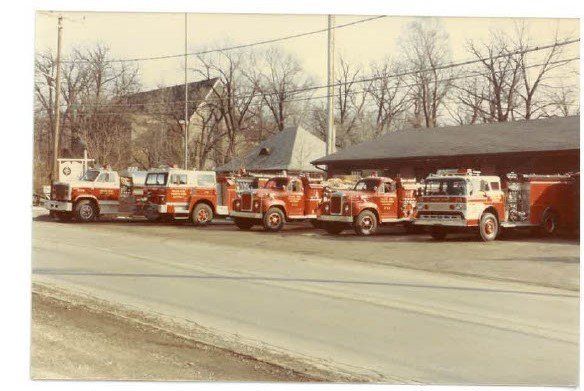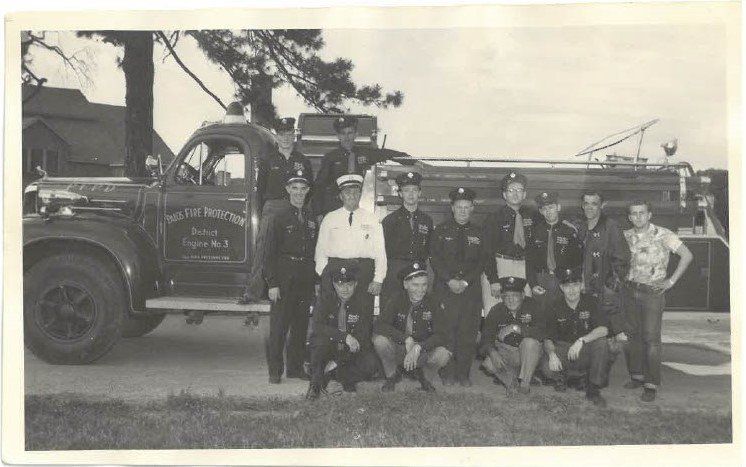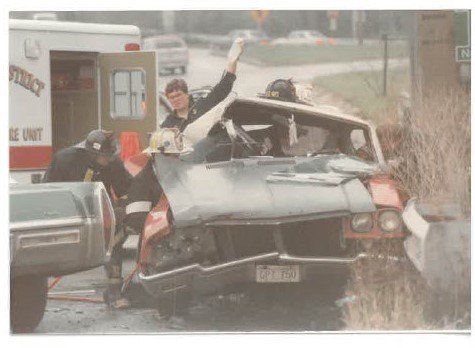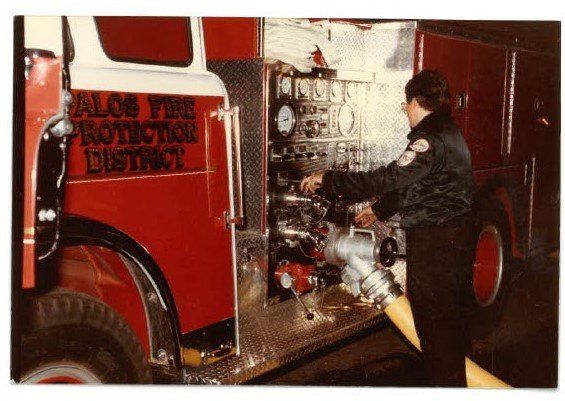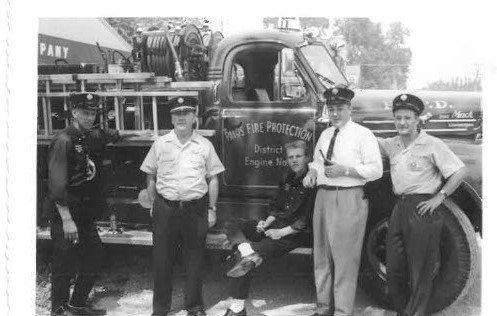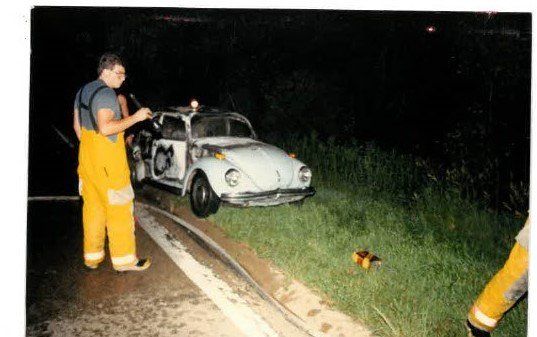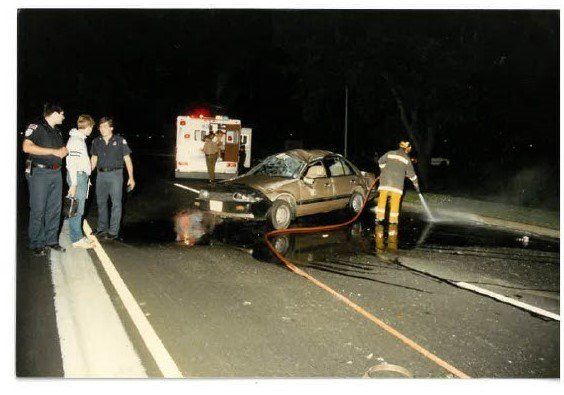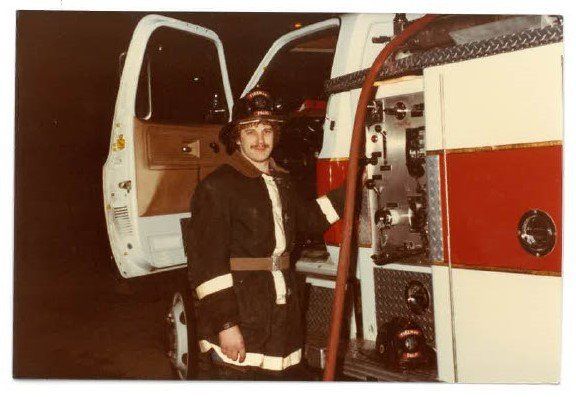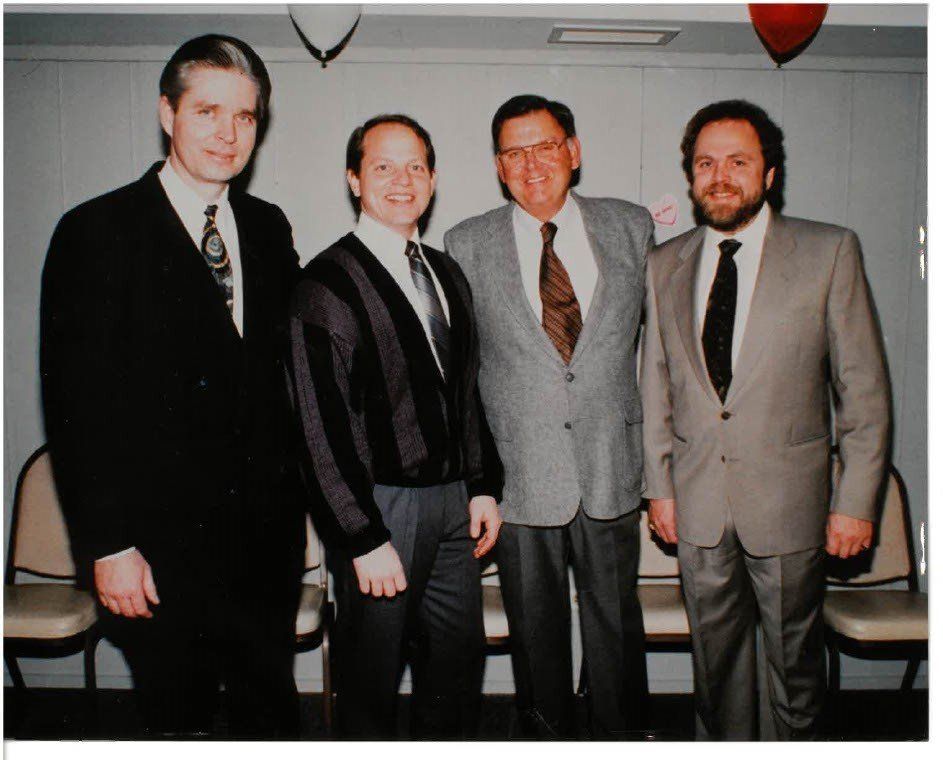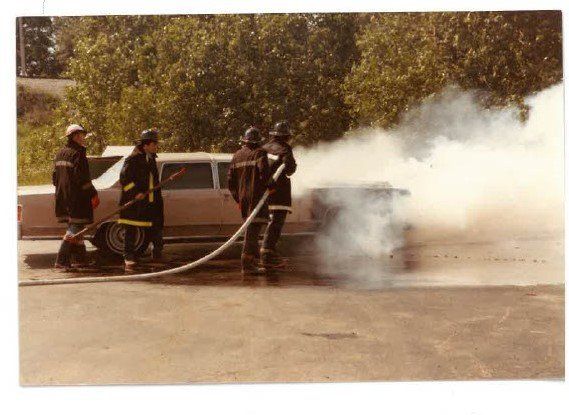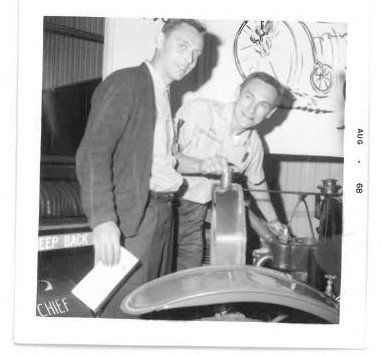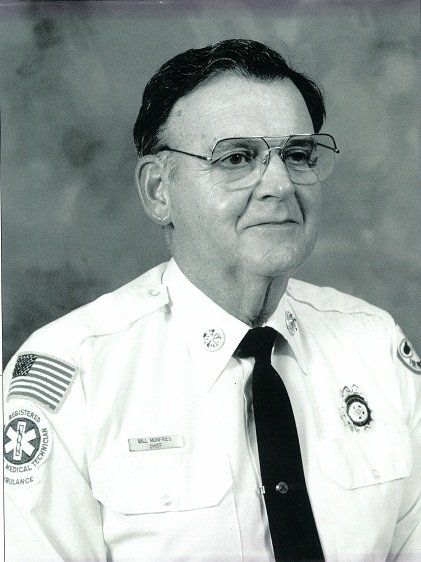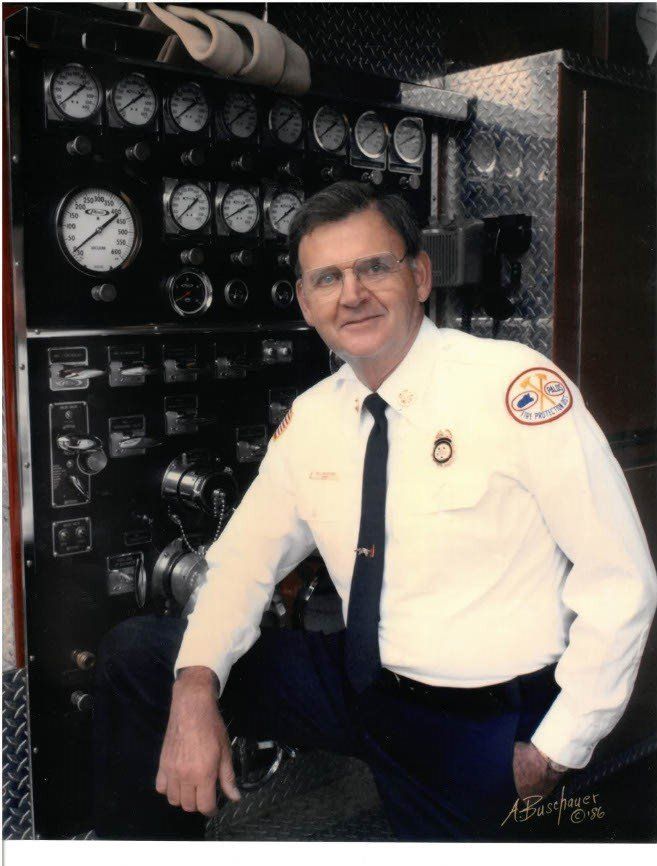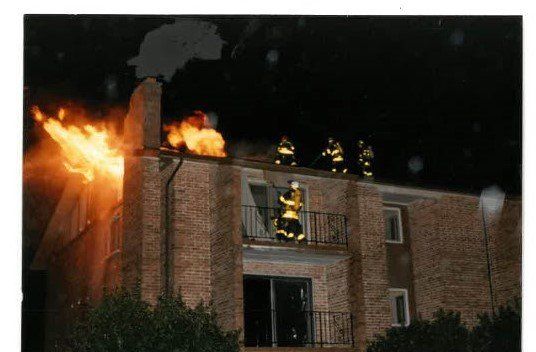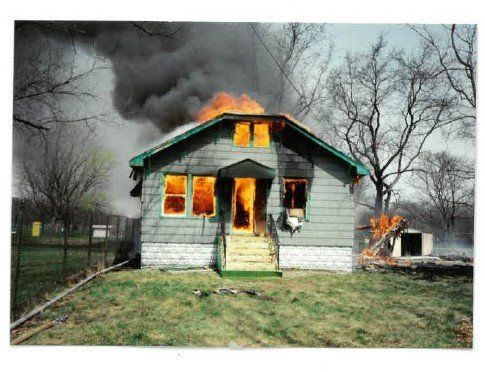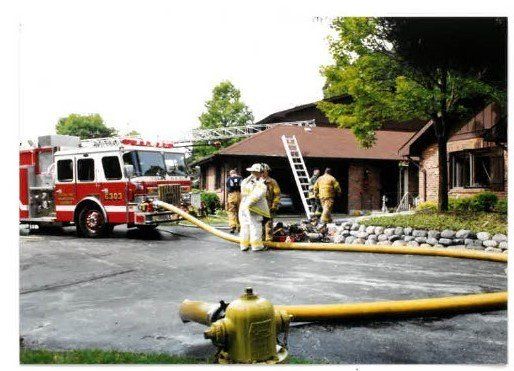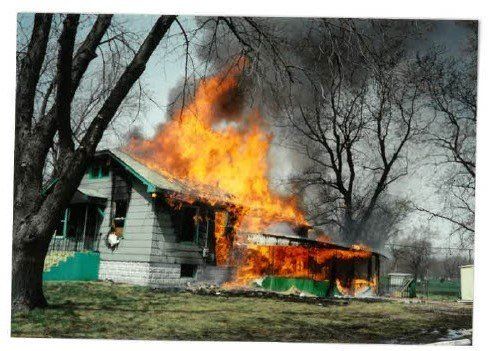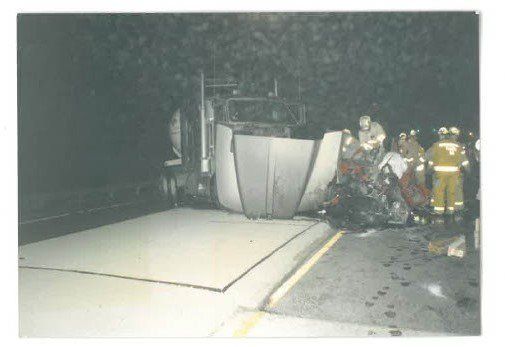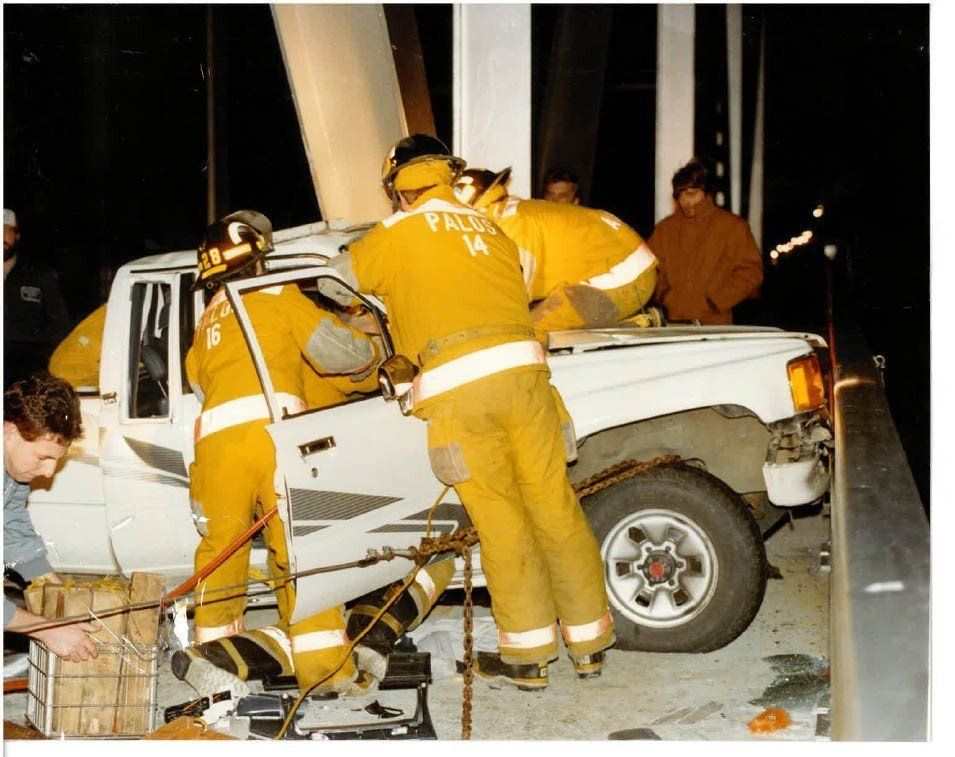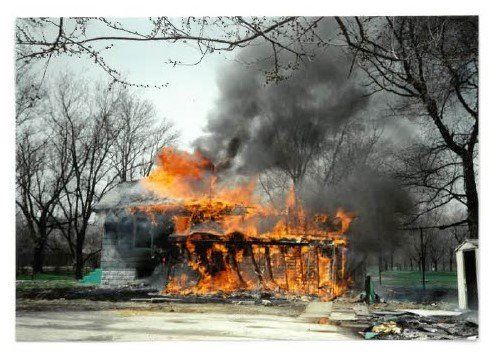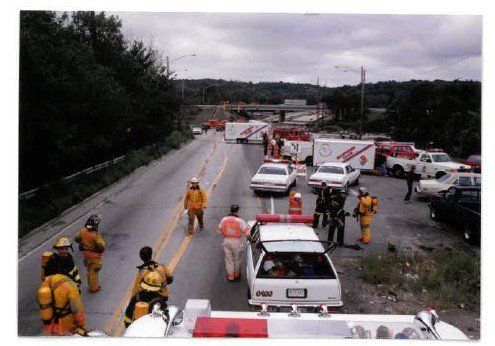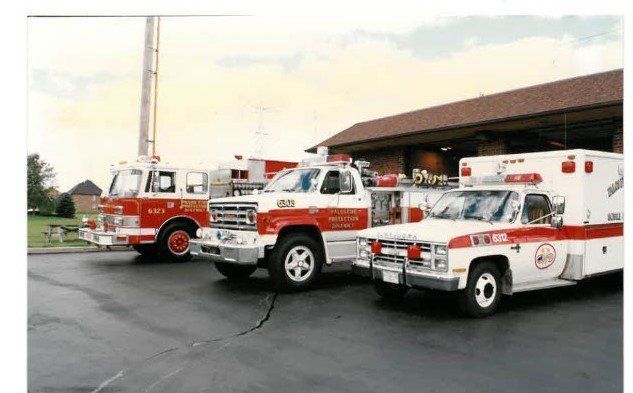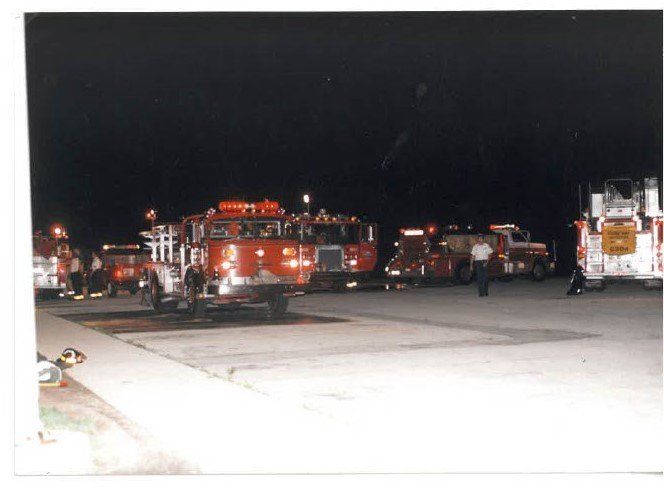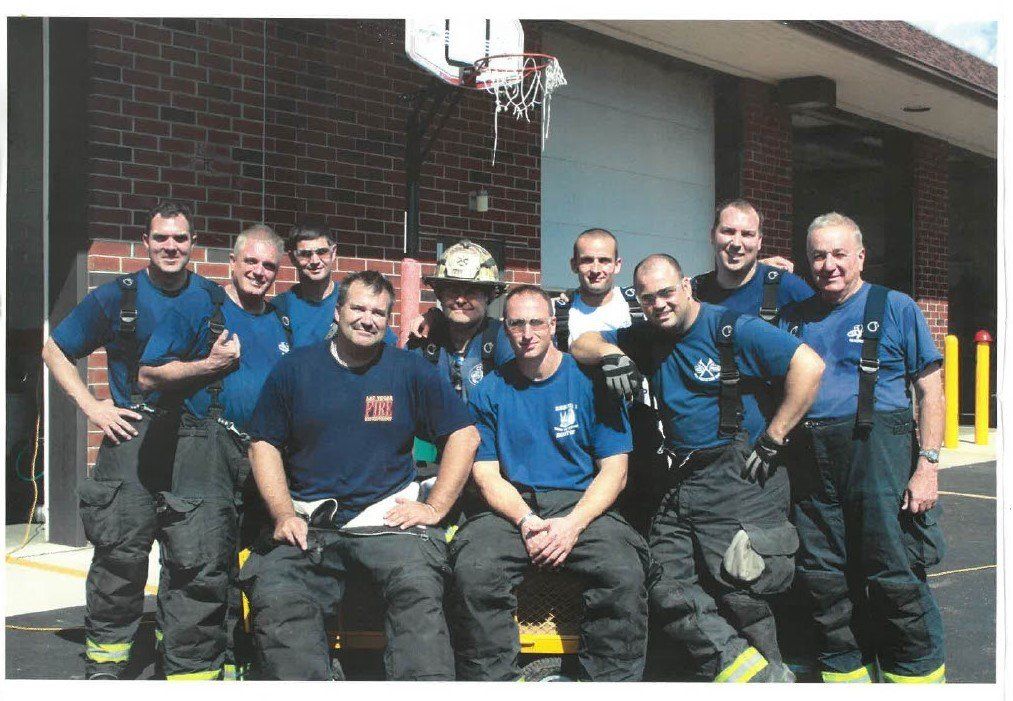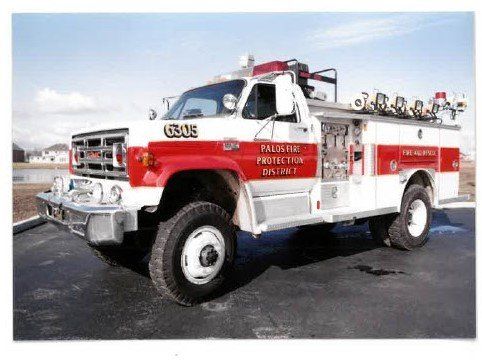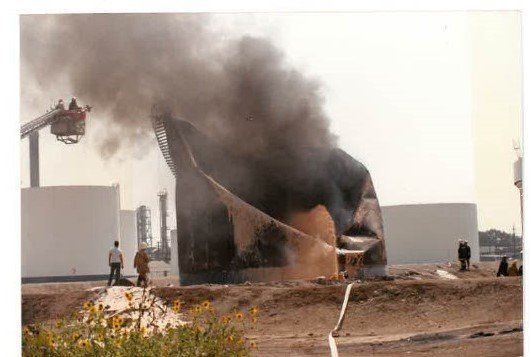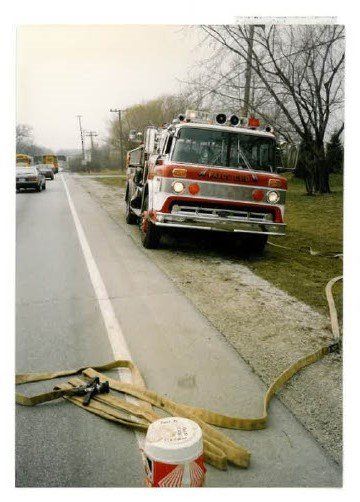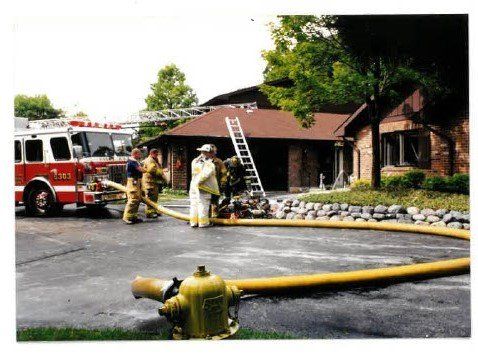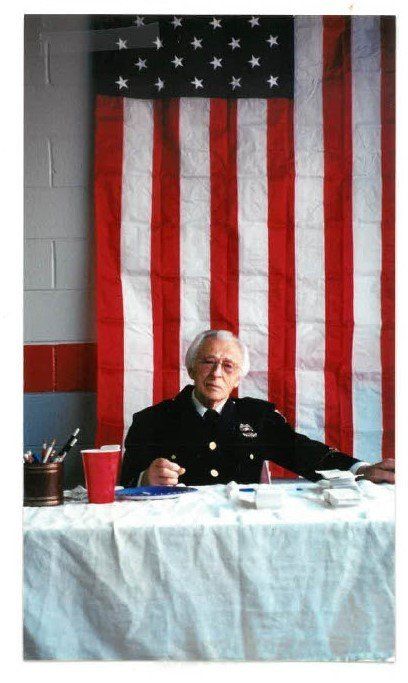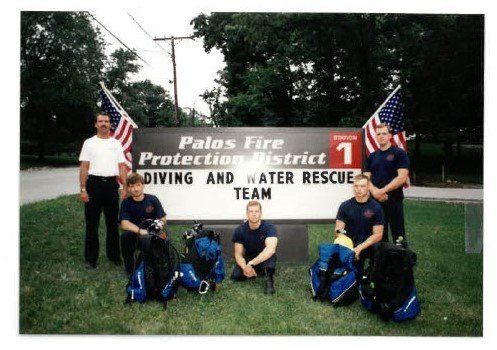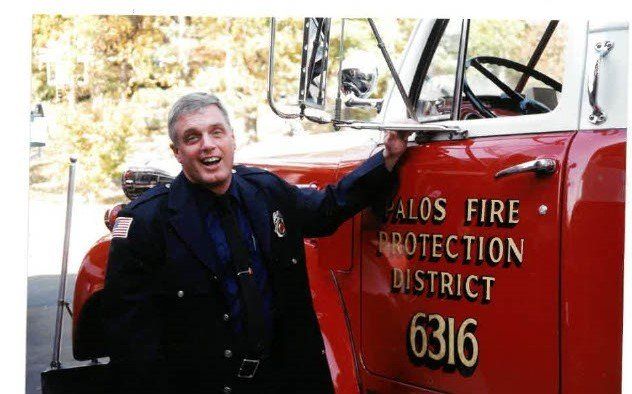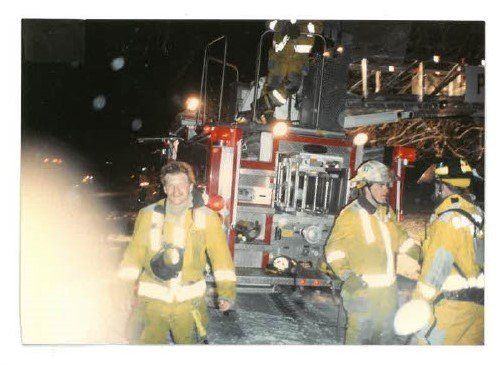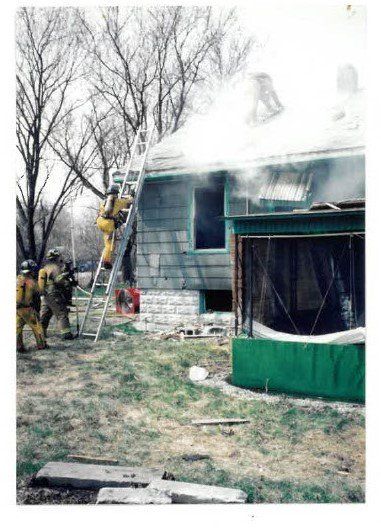The patches pictured are the progression of our patch. The top blue patch was the original patch designed by the founding members; The Village of Palos Park Fire Department was born. As the district and membership grew the need for a new patch became necessary. The department provided service for more residents beyond those in just the village of Palos Park. The membership chose the middle patch. Originally, the patch was created by the Fire Marshall George Herbachs wife. The design was made as an art piece for the fire house. A homemade picture made from seeds and flowers found in the community and arranged to compose the image pictured above. Finally, our current patch. As we progressed to a career department in 2019 the membership again took the opportunity to reshape our patch design to bridge the history of the department with the future to come. The shape of the patch and lettering are similar to the original patch, updating the department to district. The circle in the center is very reminiscent to the original patchwork. The hook and ladder have returned as did our ever-present helmet but updating the tools of the trade, a pig now sits crossed in the patch taking the place of the pick head axe. Finally, the date 1952. As you join the ranks this date is still a point of contention among some members. It is true that the district did not run their first call till around 1956 (best accounts) but through much research conflicting dates arise with both Bob DeNovos history within the department being listed as early as 1953 as well as Chief John Kettman’s State Resolution citing department affiliation beginning in 1955. None of that matters, in 1952 a founding member disregard his own well-being and answered the call. A rescue attempt was made, and a young life was lost, Susan Firalyo. This tragedy was the catalyst that immediately started our organizations existence. Would 1956 have happened without 1952, one can only speculate. 1952 is the acknowledgement of the selfless actions of a founding member, as well as a reminder of a young life lost. 1952 highlights the mission of the fire service at its most basic level. To save lives and property.
History of the Palos Fire Protection District
They approached Art Carlson and Abel DeHaan who gave them $5,000 to put down as payment on a property at the southwest corner of 123rd street and 86th Avenue (across from the Plush Horse). That location changed to the present site. Otto Kerner, circuit court judge, helped set up the Fire Prevention District. In March of 1956, the new station, designed by Zay Smith and manned with 40 volunteers, was ready to go.
Much has changed from when the wives of volunteers would answer in-coming calls and set off the sirens. In 1968, ambulance and rescue service came into being, later followed by trained paramedics. Today, calls are answered by Southwest Central Dispatch. Station #2 was built in 1989.
Excerpts from 75th Anniversary of Palos Park, by Geraldine (Dolly) DeNovo
I joined the department as a probationary cadet firefighter in April of 1977 and retired as a full-time firefighter / paramedic with the ranks of Deputy Fire Chief and Fire Marshal. The cadet program had been in place for several years. I was sponsored by Bob Stolinski and was eligible to join at an age less than 16 years old since I was brought into the organization by Bob. A probationary cadet had to be at least 15.5 years old. When a probationary cadet reached the age of 16, they were able to become a cadet, once they became 18 years old, they were eligible to become a “senior” or regular paid-on-call firefighter. The cadet program had its own internal hierarchy which included a Cadet Captain and two Lieutenants. Cadets conducted regular training on Thursday nights and were allowed to ride on the fire apparatus for training purposes. Cadets were allowed to respond to emergency calls if no other senior firefighters were available for response. All PFPD fire apparatus with the exception of the newer 1976 Pierce Hendrickson (E-236) were older style apparatus with no crew cabs requiring firefighters to ride on the rear tailboard of the rig. Cadet firefighters were allowed to perform all the functions on the scene of an emergency call with the exception of entering a burning structure. Essentially, cadets were “go-fers” on the fire ground and back at the station during clean-up and routine maintenance. Many PFPD cadets went on to full-time employment with other fire departments or were hired directly by PFPD as a full-time employee during a formal testing process.
Paid-on-Call
In April 1977 when I joined the department, I believe that the transition from being a pure volunteer organization (since the mid-1950’s) to a paid-on-call (POC) department was being initiated. I do not know the exact date that the PFPD became a POC department. POC’s were paid based on the number of calls they responded to each year. The first derivative of the POC program was based on points for budgetary purposes. Apparently, there was a fixed dollar amount budgeted by the district for call compensation. Each time a call was answered, a member would sign in on the call sheet with a code of D-5. Each call answered was worth 5 points and every full hour required after the initial hour of the call would provide an additional 5 points. At the end of the year, the total number of points would be divided by the amount budgeted subsequently determining the value of the points. POCs would then be compensated annually based on the number of points that they accumulated as individuals. At some point in time, the point system was eliminated, and a fixed dollar amount was established for answering calls and any subsequent hours. When the full-time program went into effect in 1983, the POC program remained in place and fulltime firefighters received their hourly rate when they recorded a D-5 response off duty. Additionally, there was a program known as “Rescue Squad” or “Squad” where POCs were required to answer calls at night when they were on – call for a specific period (each squad was on-call for a full week). If you were not able to make your squad because you were out of town, etc., you were expected to get someone else to cover your squad time. If you failed to report to a squad call during your assigned period, there were consequences (suspension from eligibility to respond to any call for a certain period of time).
Part-Time Staffing (Weekends)
Prior to the 1983 implementation of a limited full-time staffing program, a part-time weekend staffing program was created to cover the hours of 1900-0700 hours on Friday and Saturday nights. The minimum staffing requirement was one paramedic and one EMT. There was no bunkroom in the station when this program was implemented, and the crews slept on folding beds in the TV room which is now the workout room. The two on duty part-timers were able to immediately respond to ambulance calls but had to wait for a third person before they could respond to a fire. During this period and all times prior to that, the district would sound its land-based sirens (one siren at station 1 and two others – one on 123rd street near the railroad tracks and the other on 131st street near Palos South Jr. High School). Generally, if the siren sounded a full cycle (about 3.5 minutes) and no one showed up for a fire call, it would be activated again for another cycle. If no one showed up after a second siren cycle, the crew would respond on an engine with only a crew of two. This program stayed active until the full-time program was implemented.
Initial Full-Time Staffing
In June of 1983 after a few years of review by the Board of Trustees, a full-time program was implemented. The program consisted of 6 new employees who were all firefighter paramedics. After a testing process that was only open to PFPD POC members, six charter full-time employees were hired. There were no laws or regulations at the time requiring the hiring process to be open to the outside. The base salary was $16,500.00 plus $2,000.00 for being a certified paramedic. Three traditional 24 hour shifts were created using the Black, Red, and Gold scheduling system. Each shift had a commander (SC) and an FF/PM. The board designated the following members as the original six full time employees
- Black Shift – Steve Carr (SC) and Andy Griffin
- Red Shift – Stan Szpytek (SC) and Kent Adams *
- Gold Shift – Mike Condux (SC) and Forest Reeder
*Note: Kent Adams declined the job offer and was replaced by Fred BeBow On June 1st ,1983, Gold Shift worked the very first PFPD full-time shift.
Operationally, crews responded the same way as the original part-time weekend staffing program did. Immediate response to ambulance calls and waited for an additional crew member(s) before responding to a fire call. Within a year or two, a seventh full-time employee, Rob Knez was hired to cover the days off of the original six employees. Meaning, if an employee took a vacation or sick day, Rob would work the 24 hour shift and subtract hours from his regular work schedule (days). If Rob was not working a full twenty-four-hour shift to cover someone’s time off, he worked a regular schedule during the week on days (48 hours) to supplement full-time staffing. This swing shift person, Rob, was in this position for a few years until two more employees were hired, Arthur “Chip” Adams and Jim Graben. Additional employees were hired when Station #2 was opened on August 9th, 1990. There would be 4 full-time employees on each shift, two at station 1 and two at station 2. To increase manpower, a new part time program was created.
Part -Time Program Stations 1 & 2
With the opening of Station 2 following a referendum, a new part-time program was instituted. The purpose of this program was to supplement staffing at each station so there were 4 firefighters on duty around the clock. Many of the early part-time employees were full-time with other departments like Chicago, Burbank, Oak Lawn, and Orland. Most part-time employees came to PFPD on referral and were retained as at-will employees. Response varied through the years by using a “jump company” approach but for the most part, two medics responded on the ambulance and the Shift Commander (Station 1) and Company Officer (Station 2) followed on the engine with an engineer. For fire calls, generally 3 personnel were on the engine and one followed with the truck out of Station 1, unless the call was on Station 2 side were the numbers would reverse. Three would ride on the truck and one would ride on the engine. Station 2 responded to fire calls with 3 on an engine and 1 on the ambulance or tanker if it was a rural response. This system was in place till my retirement in June of 2003.
Stan Szpytek
Deputy Fire Chief (Retired)
Patch History

